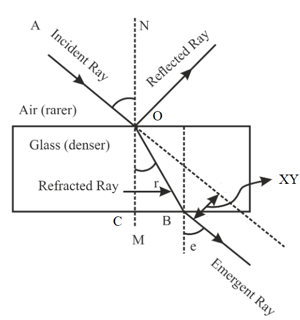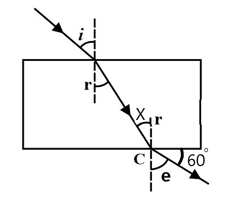Refraction through a Rectangular Glass Block
Refraction through a Rectangular Glass Block: Overview
The topic discusses light refraction on a rectangular glass block in experimental way. We will also learn about emergent ray, incident angle and lateral displacement. It also explains the phenomenon of refraction through glass.
Important Questions on Refraction through a Rectangular Glass Block
In the diagram given below, AO is a ray of light incident on a rectangular glass block. Indicate in the diagram the lateral displacement between the emergent ray and the incident ray. (Choose from: BC / OB / XY)

Explain the formation of images in a thick mirror? Will it produce multiple images?
Which image will be the brightest in case of thick mirrors?
The first image formed in a thick mirror would be the most brightest.
In case of thick mirrors, which image will be the brightest? Why?
Explain the multiple image formation in thick mirrors.
The _____ displacement of the emergent ray of light is the perpendicular distance between the original direction of the incident ray and the emergent ray coming out of the glass slab.
The angle of deviation produced by the glass slab is
If a ray of light falls perpendicularly on a glass slab, what will be its angle of refraction in degrees? (write in numbers without units)
For a certain parallel-sided glass block, the value of is . A ray of light passes through the block and emerges at an angle of to the surface of the block. What is the value of the angle marked X?

is equal to the ratio of real depth to the _____.
Which image of an object from a thick glass mirror is the brightest?
What is the term used to describe the perpendicular distance between the direction of the incident ray and the emergent ray when a ray of light is incident obliquely on a parallel-sided glass slab?
